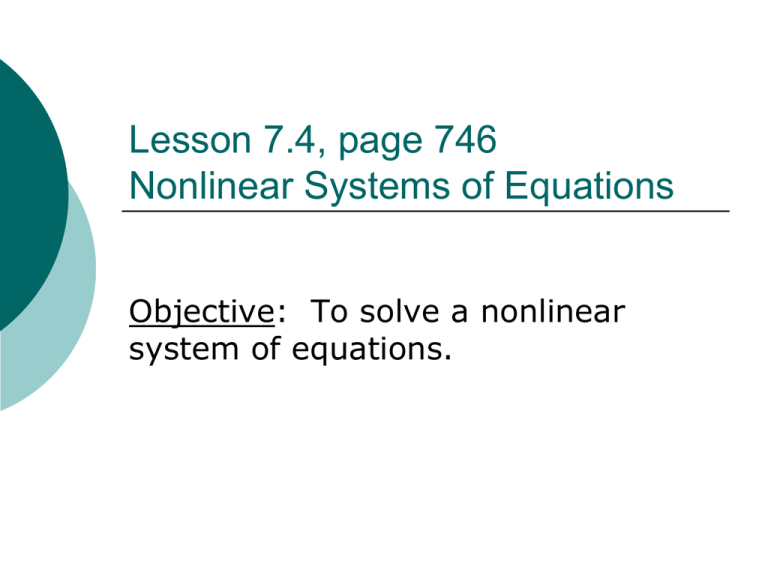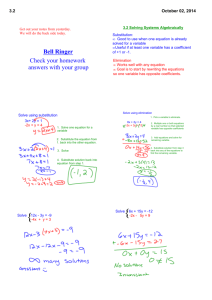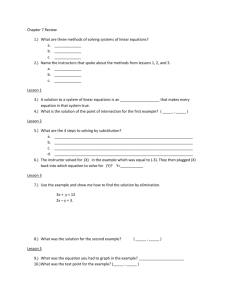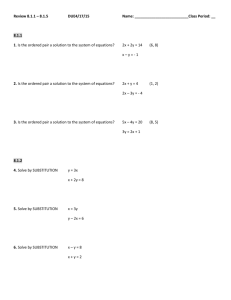Lesson 7.4, page 746 Nonlinear Systems of Equations system of equations.
advertisement

Lesson 7.4, page 746 Nonlinear Systems of Equations Objective: To solve a nonlinear system of equations. Review – What? 1. 2. 3. 4. System – 2 or more equations together Solution of system – any ordered pair that makes all equations true Possible solutions: One point More than one point No solution Infinite solutions Review - How? What methods have we used to solve linear systems of equations? 1. Graphing 2. Substitution 3. Elimination Review Steps for using SUBSTITUTION 1. Solve one equation for one variable. (Hint: 2. Substitute into the other equation. Solve this equation to find a value for the variable. Substitute again to find the value of the other variable. Check. 3. 4. 5. Look for an equation already solved for a variable or for a variable with a coefficient of 1 or -1.) Review Solve using Substitution. 2x – y = 6 y = 5x Review STEPS for ELIMINATION Review Solve using elimination. 3x + 5y = 11 2x + 3y = 7 What’s New? A non-linear system is one in which one or more of the equations has a graph that is not a line. With non-linear systems, the solution could be one or more points of intersection or no point of intersection. We’ll solve non-linear systems using substitution or elimination. A graph of the system will show the points of intersection. An Example… Solve the following system of equations: x y 9 2x y 3 2 2 (1) The graph is a circle. (2) The graph is a line. An Example… We use the substitution method. First, we solve equation (2) for y. 2x y 3 y 2 x 3 y 2x 3 An Example… Next, we substitute y = 2x 3 in equation (1) and solve for x: x 2 (2 x 3) 2 9 x 4 x 12 x 9 9 2 2 5 x 12 x 0 x (5 x 12) 0 2 12 x 0 or x 5 An Example… … Now, we substitute these numbers for x in equation (2) and solve for y. x y y y = = = = 0 2x 3 2(0) 3 3 x = 12 / 5 y 2x 3 y 2( 125 ) 3 9 y 5 SOLUTIONS (0, 3) and 12 , 9 5 5 An Example… Check: (0, 3) x2 y 2 9 2x y 3 0 3 9 99 2(0) (3) 3 33 2 3 12 9 , 5 5 x2 y 2 9 2x y 3 Check: 12 2 5 9 2 5 9 99 2( 125 ) ( 95 ) 3 33 Visualizing the Solution See Example 1, page 747 Check Point 1: Solve by substitution. x2 = y – 1 4x – y = -1 See Example 2, page 748 Check Point 2: Solve by substitution. x + 2y = 0 (x – 1)2 + (y – 1)2 = 5 Another example to watch… Solve the following system of equations: xy = 4 3x + 2y = 10 xy 4 4 y x Solve xy = 4 for y. 3 x 2 y 10 Substitute into 3x + 2y = 10. 3 x 2( 4x ) 10 3 x 8x 10 x 3x 8 x 10( x) 3 x 8 10 x 2 3 x 10 x 8 0 2 Use the quadratic formula (or factor) to solve: b b 2 4ac x 2a 10 102 4(3 8) x 2(3) x 3 x 10 x 8 0 2 x x x 10 100 96 6 10 4 10 2 6 6 10 2 10 2 and 6 6 4 and 2 3 Substitute values of x to find y. 3x + 2y = 10 x = 4/3 x = 2 3 34 2 y 10 3 2 2 y 10 4 2 y 10 6 2 y 10 2 y 6 2 y 4 y 3 y 2 The solutions are (4/3, 3) and (2, 2). Visualizing the Solution Need to watch another one? Solve the system of equations: 5 x 2 y 13 2 2 3 x 4 y 39 2 2 5 x 2 2 y 2 13 3 x 2 4 y 2 39 Solve by elimination. Multiply equation (1) by 2 and add to eliminate the y2 term. 10 x 4 y 26 2 2 3x 4 y 39 2 13x 2 13 2 x 1 2 x 1 Substituting x = 1 in equation (2) gives us: x=1 x = -1 3 x 2 4 y 2 39 3 x 2 4 y 2 39 3(1) 2 4 y 2 39 3( 1) 2 4 y 2 39 4 y 2 36 4 y 2 36 y2 9 y 3 y2 9 y 3 The possible solutions are (1, 3), (1, 3), (1, 3) and (1, 3). All four pairs check, so they are the solutions. Visualizing the Solution See Example 3, page 749 Check Point 3: Solve by elimination. 3x2 + 2y2 = 35 4x2 + 3y2 = 48 See Example 4, page 750 Check Point 4: Solve by elimination. y = x2 + 5 x2 + y2 = 25



